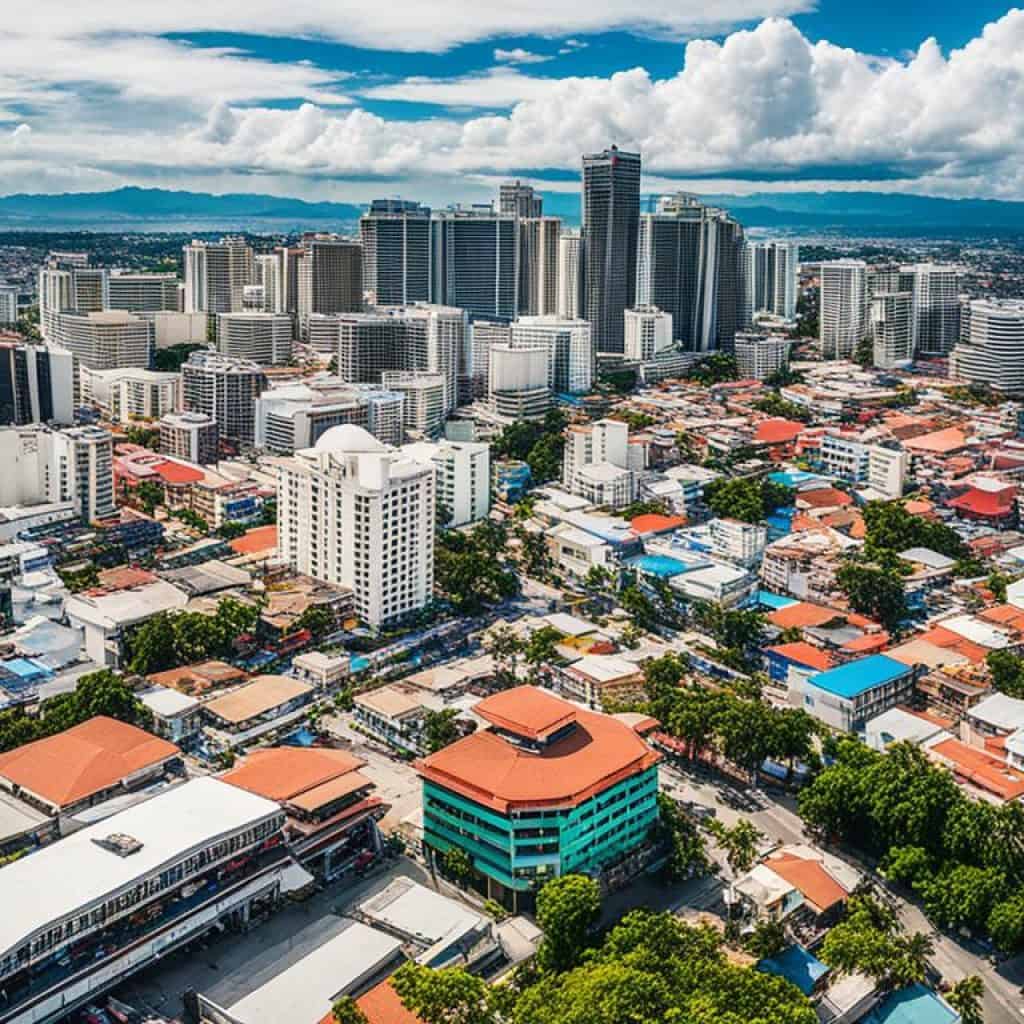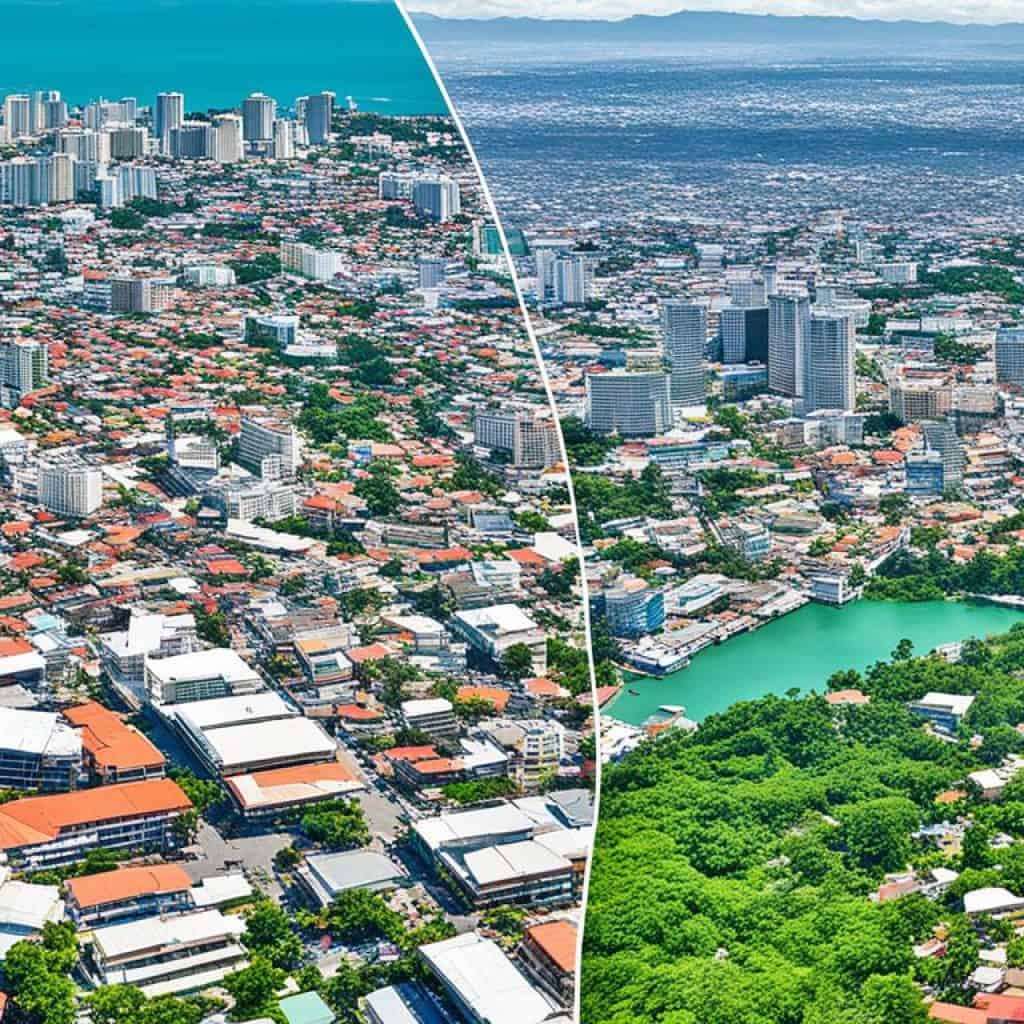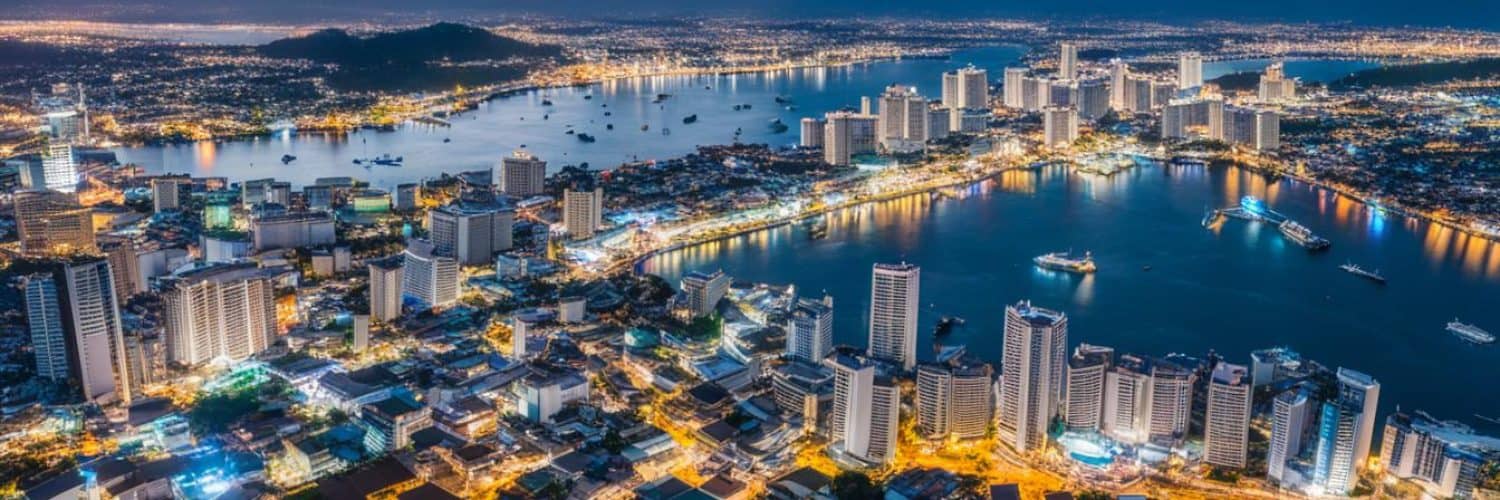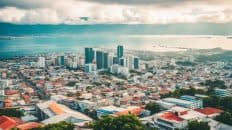What is the population of Cebu City in 2023? How has it changed over the past year? Are there any surprising demographic trends? Let’s dive into the latest population update and explore the fascinating facts about Cebu City’s population.
Key Takeaways:
- The estimated population of Cebu City in 2024 is 1,042,613.
- Over the past year, Cebu City has experienced a 1.72% annual growth rate.
- This has led to a population increase of 17,668 residents.
- The population estimates come from the latest revision of the UN World Urbanization Prospects.
- Stay tuned to discover more intriguing insights about Cebu City’s population.
Population Growth Trends
The population of Cebu City has shown remarkable growth over the years, reflecting its development and appeal as a residential area. In 1950, the population stood at 178,256, and by 2024, it has surged to 1,042,613. This consistent increase in population indicates the city’s steady growth and highlights its attractiveness as a thriving urban center.
Such population growth trends reflect the evolving landscape and growing opportunities within Cebu City. With an expanding population, the city has been able to develop and provide various resources and services to meet the needs of its residents. The increasing number of people choosing to call Cebu City home is a testament to its livability and promising future.
To better understand the impact of population growth on Cebu City, let’s take a closer look at the numbers:
| Year | Population |
|---|---|
| 1950 | 178,256 |
| 2024 | 1,042,613 |
The table above displays the population of Cebu City in 1950 and the projected population for 2024. These figures illustrate the substantial growth the city has experienced over the years, further reinforcing its status as a desirable destination for individuals and families.
Cebu City’s population growth indicates a vibrant and dynamic community that continues to flourish. As the city’s population increases, so does its potential for economic and social development, setting the stage for a prosperous future.
Demographics of Cebu City
Cebu City boasts a diverse population, reflective of its vibrant cultural heritage and growing urban center. A deeper understanding of the city’s demographics can be gleaned from the latest census data, providing valuable insights into various aspects of the population. This data encompasses crucial information, including age distribution, gender ratio, ethnic composition, and socioeconomic factors. Such statistics offer a comprehensive view of the residents residing in Cebu City, aiding in meaningful analysis and informed decision-making.
“Demographics are the building blocks that shape the fabric of a city. By delving into the census data, we gain a deeper understanding of the communities that contribute to Cebu City’s tapestry.”
Age Distribution
The age distribution within Cebu City is a key component of its demographics. Understanding the proportion of different age groups provides insights into the city’s generational composition, determining the varied needs and requirements of its residents. The census data reveals not only the current distributions but also trends that help anticipate future demographic shifts, thereby guiding policies, services, and infrastructure planning.
Gender Ratio
Gender plays an important role in the demographics of Cebu City. The census data provides a breakdown of the male and female populations, thus offering insights into the gender balance within the city. This information informs various aspects of urban planning, ranging from healthcare services to gender-specific initiatives aimed at promoting equality and inclusivity.
Ethnic Composition
Cebu City’s ethnic composition is a testament to its cultural diversity and cosmopolitan nature. The census data highlights the different ethnic groups that call the city home, shedding light on the rich cultural tapestry and heritage that contribute to its vibrant identity. This diversity fosters social inclusivity and harmonious coexistence, making Cebu City an exciting and culturally dynamic destination.
Socioeconomic Factors
Examining the socioeconomic factors within Cebu City allows for a deeper understanding of the population’s financial well-being and social status. The census data provides valuable insights into income levels, educational attainment, employment rates, and other key indicators. These details help inform policies and programs aimed at addressing social disparities, promoting equitable opportunities, and ensuring a better quality of life for all residents.
The census data provides a comprehensive picture of the demographics of Cebu City, offering valuable insights into its diverse population. The knowledge gained from analyzing this data aids in formulating effective strategies and policies for urban development, resource allocation, and meeting the evolving needs of the city’s residents.
Urban Population Dynamics
Cebu City, one of the fastest-growing cities in the Philippines, is experiencing a continuous influx of people seeking opportunities and a vibrant urban lifestyle. The city’s urban population is thriving, contributing to the dynamic growth and development of the area.
With a growing urban population, Cebu City undergoes significant changes in its infrastructure, economy, and overall landscape. The city is constantly evolving to cater to the needs of its residents and ensure sustainable development for the future.
Population projection plays a vital role in understanding the future trends and demands of Cebu City. Projections help policymakers, urban planners, and decision-makers assess the needs of the growing population and plan accordingly.
“The urban population dynamics in Cebu City provide a clear indication of its potential for economic and social growth. With careful planning and development, the city can harness its urbanization momentum for the benefit of its residents and businesses,”
Understanding the urban population dynamics in Cebu City is essential for creating sustainable urban planning strategies. It involves considering factors such as housing, transportation, public services, and infrastructure development to accommodate the growing population and ensure the city’s livability.
Evaluating Infrastructure Needs
As the population continues to grow, Cebu City must adapt its infrastructure to meet the increasing demands of urban living. Adequate transportation networks, reliable utilities, and efficient public facilities are crucial for ensuring a high quality of life for residents.
| Infrastructure | Population Impact |
|---|---|
| Transportation | Increased congestion, need for expanded road networks and public transportation systems |
| Housing | Need for affordable housing options and sustainable urban development |
| Utilities | Requirement for reliable power, water, and waste management systems |
| Public Facilities | Expansion of healthcare, schools, and recreational amenities |
“Investing in infrastructure development is a key aspect of managing urban population dynamics. By providing essential services and facilities, we can ensure a sustainable and livable environment for all residents of Cebu City,”
Economic Growth Opportunities
The urban population growth in Cebu City presents opportunities for economic expansion. With more residents, the city experiences increased consumer demand, leading to the growth of businesses and job opportunities. This upward trend fuels economic development and attracts further investment to the area.
The dynamic urban population and its evolving needs drive the diversification and growth of various industries, including retail, hospitality, services, and manufacturing. This economic growth contributes to the overall prosperity and competitiveness of Cebu City on a global scale.
It is crucial for policymakers and stakeholders to understand the population dynamics and align economic strategies with the changing needs and aspirations of the urban population.
“Cebu City’s urban population growth is a testament to its economic potential. By harnessing this growth through strategic planning and investment, we can create a thriving business environment that benefits both residents and investors,”
As Cebu City continues to embrace its urban population growth, finding a balance between economic development, environment preservation, and social well-being is paramount. By leveraging population projections and understanding the urban population dynamics, Cebu City can create a sustainable and prosperous future for its residents.
Historical Population Data
Understanding the historical population data of Cebu City provides valuable insights into its growth and development over the years. From 1950 to 2024, the population of Cebu City has experienced significant changes, reflecting the city’s evolving landscape and socio-economic dynamics.
In 1950, Cebu City had a population of 178,256, marking the starting point of its population history. Since then, the city has witnessed steady growth, with the population reaching 1,042,613 in 2024. This remarkable increase in population highlights the city’s progress and attractiveness as a residential and commercial hub.
The historical population data showcases the continuous expansion of Cebu City, indicating its ability to accommodate and support a growing number of residents. From a small population base in 1950, the city has transformed into a thriving urban center with diverse opportunities and a vibrant community.
| Year | Population |
|---|---|
| 1950 | 178,256 |
| 1960 | 268,745 |
| 1970 | 393,377 |
| 1980 | 590,330 |
| 1990 | 610,417 |
| 2000 | 718,821 |
| 2010 | 866,171 |
| 2020 | 1,015,768 |
| 2024 (forecast) | 1,042,613 |
Cebu City’s population history is a testament to its progress and development as a major urban center. It reflects the city’s ability to adapt and cater to the needs of its residents while maintaining its cultural heritage and vibrant community.
Cebu City Population Data (Urban Area)
The urban population of Cebu City encompasses not only the residents within the city limits but also those residing in the surrounding suburban areas. The total population of the urban area plays a significant role in shaping the overall dynamics and growth of the city.
According to the latest population statistics Cebu City, the urban population is a vital component of the city’s demographic landscape. The urban area of Cebu City is a diverse mix of residential, commercial, and industrial zones, contributing to its vibrant and dynamic character.
With a thriving urban population Cebu City, the city has seen sustained growth in various sectors, including commerce, tourism, and real estate. The presence of a substantial urban population provides a strong foundation for economic development and fosters a conducive environment for business activities.
The urban area’s population data Cebu City reveals important insights into the city’s social fabric as well. It highlights the diverse cultural, ethnic, and socioeconomic backgrounds of the residents, creating a rich tapestry of communities and fostering a sense of inclusivity.
Furthermore, the urban population’s statistical data Cebu City helps inform and guide urban planning and development strategies. By understanding the size, demographics, and growth patterns of the urban population, city planners can anticipate and address the evolving needs of the community.

| Year | Urban Population |
|---|---|
| 2010 | 724,992 |
| 2015 | 825,856 |
| 2020 | 925,951 |
The table above presents the urban population statistics Cebu City over the past decade. It demonstrates a consistent increase in the urban population, showcasing the city’s attractiveness as a residential destination and its steady growth.
The urban population of Cebu City is an integral part of its identity and progress. By understanding its composition and trends, the city can continue to develop and thrive, ensuring a high quality of life for its residents and maintaining its position as a dynamic urban center.
Importance of Cebu City’s Population
The population of Cebu City plays a crucial role in its development and urbanization. The city’s population growth is a reflection of its attractiveness and potential for economic and social progress. Understanding the dynamics of population growth is essential in implementing effective urban planning strategies and creating a sustainable future for the city.
Cebu City population growth is indicative of increased opportunities for businesses, industries, and employment. A growing population creates a larger consumer base, stimulating economic growth and attracting investments. It fosters innovation and entrepreneurship, contributing to the development of a vibrant and diverse business environment.
Population growth is a sign of a city’s vitality and can be a driving force for progress. As Cebu City continues to expand, it becomes increasingly attractive to individuals and businesses seeking new opportunities. Urbanization in Cebu City is a testament to its potential for growth and development in various sectors.
Moreover, a growing population promotes social and cultural diversity, enriching the city’s fabric and fostering inclusivity. As more people from different backgrounds and cultures come together, vibrant communities and a thriving cultural scene emerge. The diversity of Cebu City’s population is a significant asset that contributes to its social cohesion and dynamism.
Urbanization Cebu City is facilitated by the increasing population, as it drives the demand for infrastructure development and improved public services. The city’s ability to meet the needs of its residents and provide essential amenities such as transportation, healthcare, education, and housing depends on understanding population dynamics and planning for future growth.
By analyzing population trends and projections, policymakers and urban planners can address the challenges that arise with population growth. Planning for adequate infrastructure, efficient transportation systems, and sustainable urban spaces becomes crucial in ensuring the well-being and quality of life for Cebu City’s residents.
Harnessing the potential of Cebu City’s population growth is a pathway to sustainable development. It requires a strategic and inclusive approach to urban planning, ensuring that the city remains livable, dynamic, and resilient for future generations.
In conclusion, the population of Cebu City plays a vital role in its development and urbanization. Population growth signifies the city’s attractiveness, potential for economic growth, and societal progress. By understanding the importance of population dynamics and implementing effective urban planning strategies, Cebu City can continue to thrive as a vibrant and inclusive metropolis.
Economic Impact of Population Growth
Population growth in Cebu City has a substantial impact on its economy. As the city’s population increases, it brings about an upsurge in consumer demand, creating opportunities for businesses and stimulating economic activity. The larger population also fosters the development of various sectors and industries, contributing to overall economic growth and prosperity.
A growing population means a greater number of potential customers for businesses in Cebu City. This increased consumer demand leads to higher sales and revenue for local businesses, which, in turn, stimulates economic growth. It encourages entrepreneurs to invest in new ventures and expand existing businesses, creating more job opportunities and boosting employment rates.
The significance of population growth goes beyond consumer demand and job creation. A larger population fuels the development of key sectors such as real estate, construction, and infrastructure. As more people settle in the city, there is a greater need for housing, commercial spaces, and public infrastructure, leading to increased construction activities and investment in these areas.
The thriving population also supports the growth of the service industry. With more residents, there is an increased demand for services such as healthcare, education, hospitality, and entertainment. This spurs the establishment of new facilities, the expansion of existing institutions, and the creation of additional jobs in these sectors. The service industry’s growth further contributes to the overall economic development of Cebu City.
It is essential for policymakers and urban planners to recognize the economic impact of population growth and develop strategies to harness its potential. By promoting investment, supporting entrepreneurship, and ensuring adequate infrastructure, Cebu City can sustain its economic momentum and continue to attract businesses and opportunities.
With a larger population comes increased economic activity and opportunities. Cebu City’s economy flourishes as its population grows, creating a vibrant and thriving urban center.
| Positive Economic Impacts of Population Growth in Cebu City | Negative Economic Impacts of Population Growth in Cebu City |
|---|---|
|
|
Infrastructure Development and Population
As the population of Cebu City continues to experience steady growth, the importance of infrastructure development cannot be overstated. The city must ensure that it has the necessary transportation, housing, healthcare, education, and other facilities to meet the needs of its residents and support their quality of life.
Investing in transportation infrastructure is crucial to alleviate the potential strain on commuting and improve connectivity within the city. Effective transportation systems, including roads, bridges, and public transit options, will help ease traffic congestion and provide efficient mobility for the growing population.
In terms of housing, the city needs to prioritize the development of affordable housing options to accommodate the increasing number of residents. Adequate housing is essential for addressing the growing demand and ensuring that individuals and families have access to safe and comfortable homes.
Healthcare and education facilities must also expand to keep pace with the population growth. Accessible and quality healthcare services are crucial in providing adequate medical care for all residents. Similarly, the city should invest in expanding educational institutions to cater to the needs of students and ensure access to quality education.
“Infrastructure development plays a crucial role in supporting the needs of a growing population, contributing to their well-being, and fostering overall development.”
The city’s commitment to infrastructure development goes hand in hand with its dedication to enhancing the overall quality of life for its residents. By focusing on these essential areas, Cebu City can create an environment that is conducive to growth, economic prosperity, and social well-being.
The Importance of Sustainable Infrastructure
When planning for infrastructure development, it is crucial to prioritize sustainability. This means considering the long-term impact on the environment and the efficient use of resources. Sustainable infrastructure can help reduce the strain on natural resources, minimize pollution, and improve resilience to climate change.
Emphasizing sustainability in infrastructure development aligns with Cebu City’s commitment to creating a greener environment and ensuring the well-being of its residents for generations to come.
Investing in the Future
By proactively investing in infrastructure development, Cebu City is setting the stage for a prosperous future. A robust and well-planned infrastructure system not only supports the current population but also attracts businesses, investors, and tourists, driving economic growth and creating more opportunities for residents.
Challenges of a Growing Population
As Cebu City’s population continues to grow, it brings along a variety of challenges that need to be addressed for sustainable urban development. These challenges range from traffic congestion and housing shortage to overcrowding and strain on public services. Additionally, there are environmental concerns that come with the increased population.
One of the major challenges faced by Cebu City is traffic congestion. With more people residing in the city, the roads are becoming increasingly crowded, leading to longer travel times and reduced efficiency in daily commutes.
Another pressing issue is the housing shortage. As the population grows, the demand for housing increases. Limited availability of affordable housing options exacerbates the problem, making it difficult for residents to find suitable accommodations.
Furthermore, overcrowding is a challenge that arises due to the growing population. The limited space in urban areas becomes insufficient to accommodate the increasing number of residents, leading to cramped living conditions.
“The strain on public services cannot be ignored in the face of a growing population,” says Dr. Maria Santos, an urban planning expert. “Schools, healthcare facilities, and other essential services can become overwhelmed, affecting the quality and accessibility of public services.”
Lastly, the expanding population raises environmental concerns. The strain on natural resources, increased waste generation, and pollution become more significant as the city’s population continues to grow.
Solutions for Sustainable Development
Addressing these challenges requires proactive measures and a comprehensive approach to ensure sustainable urban development. Some strategies that can be implemented include:
- Investing in efficient public transportation systems to alleviate traffic congestion
- Encouraging affordable housing initiatives to address the housing shortage
- Implementing urban planning policies that prioritize the efficient use of space to combat overcrowding
- Expanding and improving public services to meet the needs of a growing population
- Adopting sustainable practices and promoting environmental conservation to mitigate the impact on the environment
By addressing these challenges head-on, Cebu City can pave the way for a sustainable future that balances population growth with the well-being of its residents and the preservation of its environment.
Urban Planning and Population Management
Effective urban planning and population management strategies are essential for maintaining a balanced and sustainable growth in Cebu City. With the city’s population steadily growing, it is imperative to ensure that infrastructure, services, and resources can accommodate the needs of its residents.
Urban planning plays a critical role in shaping the future development of the city. It involves careful analysis of the current and projected population trends, land use patterns, and transportation systems to create a cohesive and livable urban environment. By strategically allocating resources and optimizing land use, urban planning aims to enhance the quality of life for residents and create resilient communities.
Population management strategies go hand in hand with urban planning. These strategies focus on implementing policies and initiatives that address the challenges of population growth, such as housing affordability, traffic congestion, and environmental sustainability. By adopting measures like promoting mixed-use development, improving public transportation networks, and preserving green spaces, population management strategies aim to create a harmonious coexistence between urbanization and the surrounding environment.
The Importance of Proper Land Use
Proper land use is a cornerstone of effective urban planning and population management. By identifying suitable areas for residential, commercial, and industrial development, cities like Cebu City can optimize land resources and minimize urban sprawl. This approach helps to create compact and walkable neighborhoods, reducing the reliance on private vehicles and promoting a more sustainable and inclusive urban environment.
Urban planning and population management are essential for creating a city that can thrive amidst continuous growth and change.
Transportation Systems for a Growing City
As the population of Cebu City continues to grow, a well-designed and efficient transportation system becomes crucial to alleviate traffic congestion and ensure the smooth movement of people and goods. Urban planning and population management strategies focus on developing an integrated transportation network that includes efficient public transit, pedestrian-friendly infrastructure, and cycling lanes. These measures not only improve mobility but also contribute to reduced emissions and better air quality.
Social Services and Community Development
Effective population management involves providing access to essential social services such as healthcare, education, and public safety. Urban planners work closely with government agencies and community stakeholders to ensure that the needs of a growing population are met. By strategically locating schools, hospitals, and other public facilities, cities can create vibrant and inclusive communities that foster social cohesion and enhance the overall quality of life.
Concluding Thoughts
Urban planning and population management are essential for creating a city that can thrive amidst continuous growth and change. By adopting sustainable land use practices, developing robust transportation systems, and providing adequate social services, Cebu City can navigate the challenges and harness the opportunities that come with a growing population. It is through these strategies that the city can achieve a harmonious balance between urban development and the preservation of its natural and cultural heritage.

Future Population Projections
Understanding the future growth and demographic trends of Cebu City is crucial for policymakers, urban planners, and decision-makers. Population projections provide valuable insights that help in planning for infrastructure, services, and policies to accommodate the changing population dynamics.
According to the latest data, the population of Cebu City is projected to continue growing in the coming years. These projections take into account factors such as birth rates, migration patterns, and mortality rates.
“Population projections serve as a compass for guiding the city’s development and ensuring its preparedness for the future. They assist in anticipating the needs of the growing population and aligning services and resources accordingly.”
– Mayor Joseph Fernandez
Population forecasts enable urban planners to estimate the demand for housing, transportation, healthcare, education, and other essential services. By understanding the future population composition, policymakers can make informed decisions and develop sustainable strategies to meet the needs of the residents.
Key Insights from Population Projections
Population projections offer valuable insights into the future growth and development of Cebu City. Some of the key insights include:
- The expected increase or decrease in the population size
- The age distribution of the population
- The impact of migration on the overall population
- The implications for healthcare services and infrastructure
- The potential need for additional schools and educational facilities
With this information, stakeholders can plan and allocate resources effectively, ensuring the city remains vibrant and sustainable.
By utilizing population projection data, Cebu City can respond proactively to the challenges and opportunities associated with a growing population. It enables the city to adapt and provide the necessary infrastructure, services, and policies required to support the evolving needs of its residents.
Population projections act as a guide for urban planners and decision-makers, enabling them to shape the future of Cebu City in a way that fosters economic growth, quality of life, and sustainable development.
Impact of Population on Social Services
The increasing population of Cebu City has a significant impact on social services, including healthcare, education, and public safety. As the city’s population continues to grow, it becomes crucial to address the needs of its residents and ensure the accessibility and quality of these essential services.
Healthcare is one of the key areas affected by population growth. With more people in need of medical services, healthcare facilities must be adequately equipped to handle the increased demand. This includes expanding hospitals, clinics, and healthcare centers, as well as recruiting and training healthcare professionals to meet the growing population’s needs.
Education is another social service that must adapt to the population increase. More students mean additional classrooms, teachers, and resources to provide quality education for all. It’s essential to invest in educational infrastructure and ensure that students have access to well-equipped schools and educational materials.
“Meeting the needs of a growing population requires adequate resources and planning to ensure access and quality of these services.”
Public safety is also impacted by population growth. As the number of residents increases, so does the demand for law enforcement and emergency services. Additional police officers, firefighters, and emergency medical personnel are needed to maintain public safety and respond effectively to emergencies.
The Healthcare System in Cebu City
Cebu City’s healthcare system plays a critical role in providing medical services to its residents. The city has several hospitals, both public and private, that offer a range of healthcare services, including specialized treatments. These institutions employ skilled healthcare professionals who work tirelessly to ensure the well-being of the city’s population.
However, the increasing population poses challenges to the healthcare system. The demand for healthcare services may outstrip the available resources, leading to longer wait times, overcrowded facilities, and potential strain on the quality of care. It is crucial to address these challenges by investing in healthcare infrastructure and implementing innovative solutions to meet the healthcare needs of the growing population.
| Impact of Population on Social Services | Challenges | Solutions |
|---|---|---|
| Healthcare | Increased demand, strain on facilities and resources | Expanding healthcare facilities, recruiting and training professionals, investing in healthcare infrastructure |
| Education | Additional classrooms, teachers, and resources needed | Investing in educational infrastructure, providing well-equipped schools and educational materials |
| Public Safety | Greater demand for law enforcement and emergency services | Increase personnel, enhance emergency response capabilities |
“It is crucial to address these challenges by investing in healthcare infrastructure and implementing innovative solutions to meet the healthcare needs of the growing population.”
Meeting the needs of a growing population requires proactive planning, collaboration between government agencies and stakeholders, and adequate funding. By addressing the impact of population growth on social services, Cebu City can ensure that its residents have access to essential services and improve their overall quality of life.
Population and Cultural Diversity
Cebu City is renowned for its vibrant cultural diversity, which is deeply embedded in its rich heritage. The city has become a melting pot of various ethnic groups, creating a multicultural environment that fosters inclusivity and social cohesion.
The demographics of Cebu City reflect its diverse population, with residents from different cultural backgrounds coming together to form a vibrant community. This cultural diversity is evident in the city’s cuisine, traditions, festivals, and languages spoken.
Understanding the demographics and cultural diversity of Cebu City provides a holistic perspective of the city’s identity. It allows for the appreciation of different cultures, traditions, and beliefs, fostering an environment of acceptance and respect.
“Cultural diversity is the backbone of Cebu City’s vibrant and inclusive society. It is what makes our city unique and fascinating.” – Mayor of Cebu City
The presence of cultural diversity in Cebu City also contributes to the development of various art forms, music, and performing arts. Local artists and performers draw inspiration from the city’s diverse cultural landscape, showcasing the richness and beauty of Cebuano culture.
The Impact of Cultural Diversity
Cultural diversity brings numerous benefits to Cebu City. It encourages creativity, innovation, and collaboration among individuals from different cultural backgrounds. The exchange of ideas and perspectives leads to a dynamic cultural scene, promoting cultural tourism and economic growth.
Furthermore, cultural diversity fosters social cohesion and harmony among the city’s residents. By embracing different cultures and traditions, Cebu City cultivates an environment of mutual understanding and respect, minimizing prejudice and discrimination.
Promoting Cultural Inclusivity
Efforts to promote cultural inclusivity in Cebu City are evident through various initiatives. The city government organizes cultural events, festivals, and exhibitions that celebrate the diversity of its population, providing platforms for different cultural groups to showcase their heritage.
Additionally, educational institutions play a crucial role in promoting cultural inclusivity. They teach students about the importance of cultural diversity and encourage appreciation for different cultures through programs and activities.
Environmental Impact of Population Growth
The growing population of Cebu City has a significant impact on the environment. As urbanization increases and resources are consumed at a higher rate, it leads to environmental degradation, pollution, and a strain on natural resources. The sustainability of Cebu City is crucial for a more sustainable future.
“Population growth and urbanization have profound effects on the environment. As more people move into cities like Cebu City, there is an increased demand for housing, transportation, and energy. This puts pressure on the environment, resulting in deforestation, air and water pollution, and the depletion of natural resources. It is essential to implement sustainable practices and conservation efforts to mitigate these effects and ensure the long-term well-being of the city.”
Cebu City must take proactive steps towards sustainability. One way to address the environmental impact of population growth is by promoting sustainable urban planning and design. This includes creating green spaces, implementing renewable energy sources, and improving public transportation systems to reduce carbon emissions.
Another important aspect is promoting waste management and recycling programs to reduce the amount of waste sent to landfills. By implementing effective waste disposal systems and encouraging recycling, Cebu City can minimize its environmental footprint and conserve resources.
The Importance of Biodiversity Conservation
Biodiversity conservation is crucial for maintaining a balanced and thriving ecosystem in Cebu City. Protecting natural habitats and promoting biodiversity can help mitigate the negative impacts of urbanization and population growth.
Preserving green spaces, such as parks and wildlife reserves, provides a habitat for various plant and animal species and promotes ecological balance. These green spaces also offer opportunities for recreation and improve the quality of life for residents.
Cebu City should prioritize the protection of its natural resources and biodiversity by implementing laws and policies that safeguard the environment. This includes enforcing regulations against illegal logging, controlling pollution from industries, and promoting sustainable agricultural practices.
Education and Awareness
Education and awareness play a vital role in mitigating the environmental impact of population growth. By increasing public awareness about sustainability and the importance of preserving the environment, individuals can make informed choices that contribute to a greener and more sustainable Cebu City.
Collaboration with educational institutions, community organizations, and environmental advocacy groups can help disseminate information and promote sustainable practices. This includes educating residents about waste reduction, energy conservation, and the benefits of sustainable transportation options.
By empowering the community with knowledge and fostering a sense of responsibility towards the environment, Cebu City can work towards a more sustainable future and minimize the environmental impact of its growing population.
Conclusion
The population of Cebu City is projected to reach 1,042,613 in 2024, reflecting a 1.72% annual growth rate. This steady population increase has significant implications for the city’s development in terms of infrastructure, economy, and social services. To ensure the continued growth and prosperity of Cebu City, it is crucial to implement sustainable population management and urban planning strategies.
With such a growing population, Cebu City needs to address various challenges such as traffic congestion, housing shortage, strain on public services, and environmental concerns. Effective urban planning and resource allocation are essential to create a balanced and livable city for residents.
Furthermore, the increasing population of Cebu City presents opportunities for economic growth, job creation, and cultural diversity. By leveraging these opportunities and addressing the challenges, Cebu City can strengthen its position as a vibrant and sustainable urban center.


















Add comment